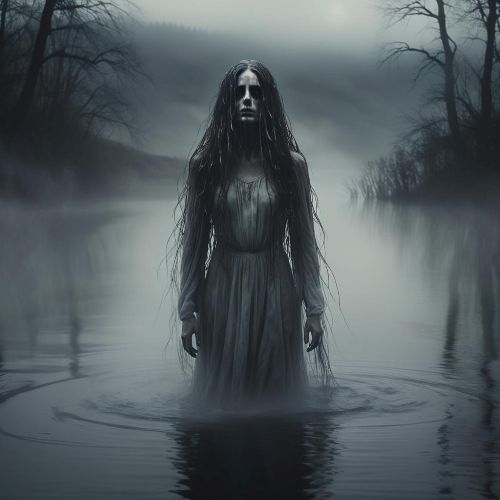Korean Ghosts
Korean ghosts, known as gwishin (귀신), are among the most haunting and symbolic figures in Korean mythology and folklore. Unlike Western depictions of formless spirits, Korean ghosts are deeply tied to cultural values and the spiritual beliefs surrounding death, the afterlife, and unresolved emotions. They are often seen as restless souls unable to move on due to unfinished business, unfulfilled desires, or improper funerary rites. This makes them both tragic and terrifying, embodying themes of justice, grief, and vengeance.
One of the most well-known Korean ghosts is the cheonyeo gwishin, or virgin ghost. She is often depicted wearing a white funeral gown with long, unkempt black hair, wandering the earth in sorrow because she died before marriage. Her story reflects the cultural importance of family, duty, and traditional expectations. Other prominent ghosts include mul gwishin (water ghosts), who haunt rivers and lakes after drowning, and the spirits of soldiers who linger on battlefields, unable to rest due to violent deaths. Each type of ghost reflects a different facet of Korean society, from honor and duty to tragedy and revenge.
Beyond mythology, Korean ghosts also play a role in shamanistic rituals and ancestor veneration. Shaman priests, or mudang, often performed ceremonies to appease these spirits, ensuring they did not bring misfortune to the living. These practices reinforced the belief that the dead and living worlds remain interconnected, and neglecting one could bring consequences to the other.
In modern times, Korean ghosts have become central to horror cinema, dramas, and literature. Films such as A Tale of Two Sisters and popular K-dramas often reinterpret traditional ghost stories, blending folklore with contemporary fears. Their chilling presence has also spread globally, captivating audiences with uniquely Korean elements of supernatural storytelling.
Today, Korean ghosts continue to symbolize the cultural relationship between memory, ritual, and unresolved fate. Whether feared in folktales, honored in ancestral rites, or reimagined on screen, gwishin remain an enduring part of Korea’s spiritual and cultural identity.
Korean ghosts, known as gwishin (귀신), are among the most haunting and symbolic figures in Korean mythology and folklore. Unlike Western depictions of formless spirits, Korean ghosts are deeply tied to cultural values and the spiritual beliefs surrounding death, the afterlife, and unresolved emotions. They are often seen as restless souls unable to move on due to unfinished business, unfulfilled desires, or improper funerary rites. This makes them both tragic and terrifying, embodying themes of justice, grief, and vengeance.
One of the most well-known Korean ghosts is the cheonyeo gwishin, or virgin ghost. She is often depicted wearing a white funeral gown with long, unkempt black hair, wandering the earth in sorrow because she died before marriage. Her story reflects the cultural importance of family, duty, and traditional expectations. Other prominent ghosts include mul gwishin (water ghosts), who haunt rivers and lakes after drowning, and the spirits of soldiers who linger on battlefields, unable to rest due to violent deaths. Each type of ghost reflects a different facet of Korean society, from honor and duty to tragedy and revenge.
Beyond mythology, Korean ghosts also play a role in shamanistic rituals and ancestor veneration. Shaman priests, or mudang, often performed ceremonies to appease these spirits, ensuring they did not bring misfortune to the living. These practices reinforced the belief that the dead and living worlds remain interconnected, and neglecting one could bring consequences to the other.
In modern times, Korean ghosts have become central to horror cinema, dramas, and literature. Films such as A Tale of Two Sisters and popular K-dramas often reinterpret traditional ghost stories, blending folklore with contemporary fears. Their chilling presence has also spread globally, captivating audiences with uniquely Korean elements of supernatural storytelling.
Today, Korean ghosts continue to symbolize the cultural relationship between memory, ritual, and unresolved fate. Whether feared in folktales, honored in ancestral rites, or reimagined on screen, gwishin remain an enduring part of Korea’s spiritual and cultural identity.



